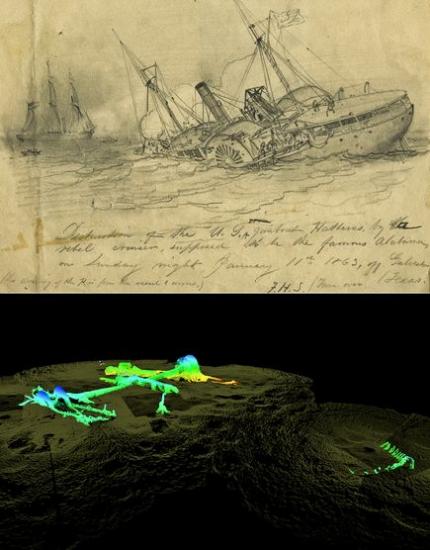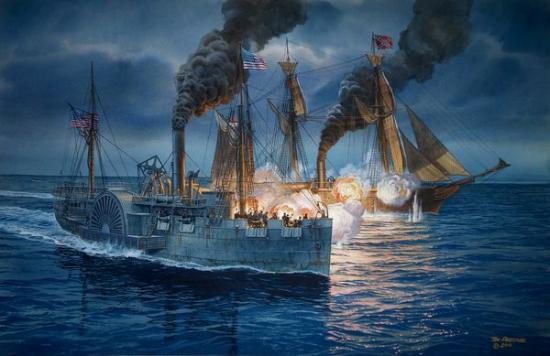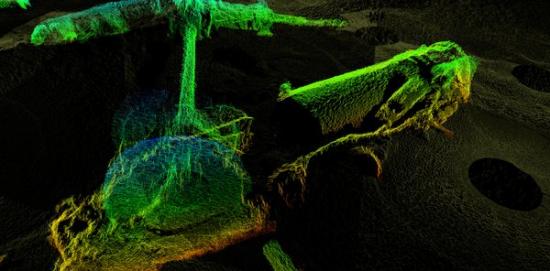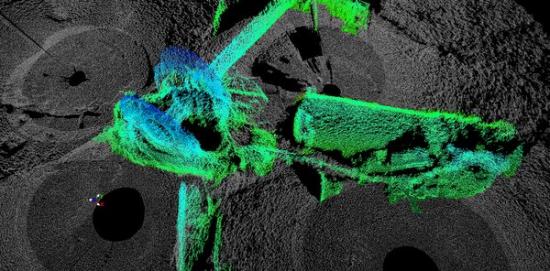Jane J. Lee /
Source - http://news.nationalgeographic.com/news/2013/01/pictures/130111-uss-hatteras-shipwreck-civil-war-archeology-science/?utm_source=feedburner&utm_medium=feed&utm_campaign=Feed%3A+ng%2FNews%2FNews_Main+%28National+Geographic+News+-+Main%29

Illustration courtesy Becker Collection, Boston College; sonar image courtesy Teledyne BlueView and James Glaeser, Northwest Hydro
New 3-D images (bottom picture) released today by the U.S. National Oceanic and Atmospheric Administration (NOAA) show the Civil War-era gunboat U.S.S Hatteras in exquisite detail.
Severe storms, such as 2008's Hurricane Ike, have moved sand off of the shipwreck that sank during a battle exactly 150 years ago, on January 11, 1863.

Illustration courtesy Tom Freeman
On this day 150 years ago, the Hatteras, under the command of Hommer Blake, tried to prevent a Confederate commerce raider, the Alabama, from running a blockade set up around the port of Galveston, Texas.
Woefully outgunned—as shown in the above painting, "The Fatal Chase"—the Hatteras was blown full of holes and sank to the bottom, taking two men in the engine room with her.
Archived documents state that the two crew members who died were Irish immigrants, Delgado said. They may have joined the U.S. Navy to gain citizenship, or to escape harsh economic times, he speculated.
"And they paid the full measure for their service. Did they set out to die in a burning, steam-filled engine room? No, but they stayed at their station."

Steam Power - Sonar image courtesy Teledyne BlueView and James Glaeser, Northwest Hydr
Part of the steam cylinders (pictured in a closeup) that powered the Hatteras' paddle wheels has started poking above the sand.
Built in Wilmington, Delaware (map), and launched in 1861, the ship was originally christened the St. Mary. President Lincoln had recently established a blockade of U.S. ports, but the Navy did not have enough ships to enforce it, said Delgado.

Starboard Paddle Wheel - Photograph by Jesse Cancelmo
So they immediately purchased the St. Mary, retrofitted her as a gunboat, renamed her the U.S.S. Hatteras, and sent her to Florida for blockade duty.
Resting in 57 feet (17 meters) of water, the shifting sands enabled archaeologists to go in with high-resolution sonars and map newly uncovered parts of the wreck.
The resolution is so good, "it's almost photographic," said archaeologist James Delgado, director of maritime heritage for NOAA's Office of National Marine Sanctuaries. Delgado and his collaborators have also produced fly-through animations of the historic site and war grave.
"You literally are giving people virtual access to the incredible museum that sits at the bottom of the sea," he said.

Full of Holes - Sonar image courtesy Teledyne BlueView and James Glaeser, Northwest Hydro